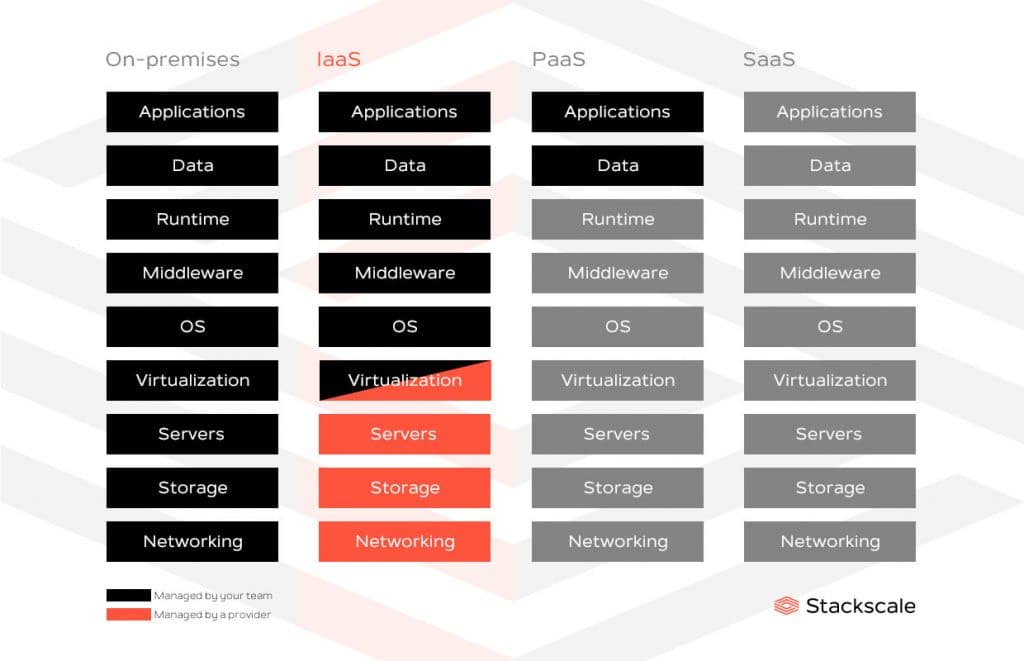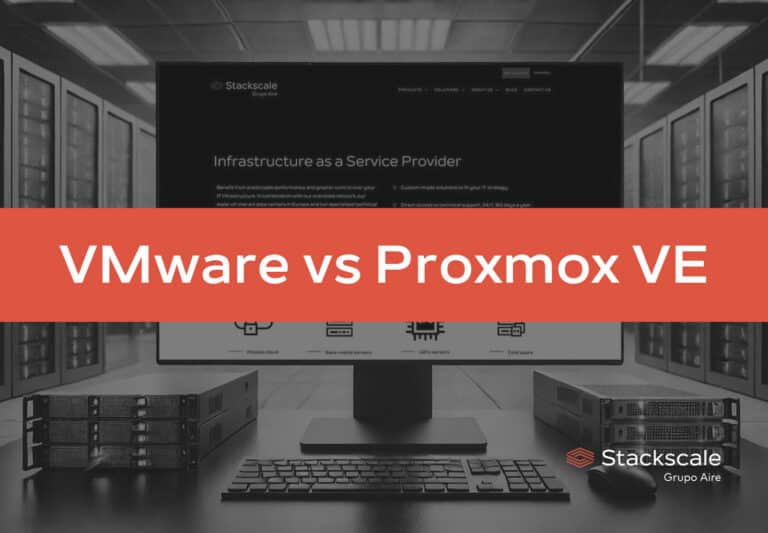IaaS, short for Infrastructure as a Service, is a cloud computing solution that consists of provisioning and managing computing resources over the Internet; such as servers, storage, networking and virtualization.
This computing model emerged in the early 2010s and, since then, it has become the standard model for numerous types of workloads. It is also known as Hardware as a Service (HaaS) or cloud infrastructure services.
Infrastructure as a Service
Infrastructure as a Service or IaaS provides businesses with the technology and capabilities of high-standard data centers. This way, companies delegate the cost and complexity of building and managing physical servers. They access their IT infrastructure via a dashboard or API instead.
IaaS Market
The Infrastructure as a Service market, although led by public cloud hyperscalers, includes many specialized providers that offer competitive, alternative solutions. In this respect, private cloud, hybrid and multi-cloud solutions continue to gain popularity. This is closely related to the rise of data protection, business continuity and security concerns.
The IaaS market is expected to grow up to 195 billion USD by 2026 (from about 82 billion USD in 2022), according to a report by Research and Markets.
What kind of resources are usually provided on IaaS?
IaaS providers deliver on-demand computing capacity, storage and network connectivity over the Internet, on a pay-per-use or pay-as-you-go basis. It is also possible to offer specialized hardware such as FPGAs or GPUs for Artificial Intelligence (AI) projects.
The physical and virtualized resources offered by cloud service providers allow businesses to run applications and workloads in the cloud.
Examples of IaaS services
- Private cloud environments
- Public cloud environments
- Bare-metal servers
- GPU servers
- Storage systems
- Cold spares
- Hyperconverged infrastructure
What are the benefits of IaaS?
Infrastructure as a Service is very advantageous for companies in terms of flexibility, efficiency, scalability and security. By “renting” computing resources, instead of purchasing them, companies save time and money, and increase agility.
These are some of the main advantages of this cloud service model.
Lower capital expenses
IaaS makes it easier for companies to develop big projects without investing a great amount of money on IT equipment. Thanks to which, companies can also save a lot of time and effort.
By outsourcing the infrastructure, companies eliminate the capital investment of setting up, managing and maintaining an on-premises data center. Thus only paying for the resources they really need and use. IaaS providers are responsible for managing the data centers hosting the physical machines that are made available to customers over the Internet, either virtualized or not.
In terms of costs and investments, cloud infrastructure services help optimize expenses by delegating the management of servers or nodes, storage and networking to a cloud computing provider. In some cases, companies can also delegate the virtualization layer to their provider.

Increased productivity
Besides, avoiding the purchase and management of hardware does not only save companies money. It also allows their internal IT teams to focus on tasks that are more valuable to the core business.
Companies remain in control of their applications, data, runtime, middleware and operating system (OS). They continue to be responsible for purchasing, configuring and managing their software. But the provider takes care of housing, managing and monitoring the technical infrastructure, so that everything works perfectly.
Furthermore, as mentioned above, the company’s IT team does not have to worry about the creation, management and maintenance of the physical infrastructure.
By migrating from an on-premises model to an IaaS model, companies will have more time to focus on the core business while their provider’s specialized team does what it does best: taking care of the infrastructure.
Increased security and redundancy
Security is another advantage of Infrastructure as a Service. Providers set up their infrastructure in big data centers, which implement the strictest physical security and redundancy measures — which add up to their own security measures. Therefore, the security level they offer is usually higher than the one a company can attain in house.
At Stackscale, for example, all elements within our infrastructure are redundant to provide a fault-tolerant service — from the power feeds to the nodes themselves.
Improved business continuity
Moreover, infrastructure service providers usually provide backup and DR solutions to help companies keep their data protected. This is also important in terms of costs, since companies would need to invest a greater amount of money and human resources in order to achieve the high availability, business continuity and Disaster Recovery cloud providers offer.
For further details about DR planning in the cloud, here is a quick guide about how to build a Disaster Recovery plan.
Scalability and performance
Companies also have more flexibility to scale their infrastructure up and down, on demand, as their project evolves. Besides, they can more easily adapt their infrastructure to meet seasonal demand.
Moreover, this kind of computing solution allows companies to always benefit from the latest technologies. Since IaaS providers, like Stackscale, have an expert team who stays tuned to the latest trends and technologies. In addition to working with innovative technologies to offer maximum performance.
To sum up, IaaS main advantages are:
- Greater control over the IT infrastructure.
- Cost-efficiency without big hardware investments.
- Increased productivity, efficiency and security thanks to automation.
- Scalability and flexibility to grow on demand.
What is the difference between IaaS and virtualization?
The term “virtualization” only refers to the capacity to simulate a physical computer into a virtual environment; which enables an optimized use of the resources and greater security. IaaS is born from this very concept, as a service model that allows making the most of the servers’ resources and virtualizing at more competitive prices.
What is the difference between IaaS and PaaS?
On the one hand, the IaaS or Infrastructure as a Service model provides the computing resources companies need to host, build and run their services.
On the other hand, the PaaS or Platform as a Service model provides an environment for developers to build and deploy applications.
To sum up, companies can choose IaaS for deploying a wide range of workloads and applications, like:
- Web applications
- CRM
- Big Data analysis
- Data storage
- Backup and Disaster Recovery
To make the most of this model, it is important to choose the provider that better fits the business needs and strategy. Some examples of IaaS providers are: Stackscale, AWS, VMware and OVH. Besides, there are different types of cloud among which companies can choose depending on their needs and goals.
Do you want to optimize your company’s IT resources?
Please do not hesitate to contact us. We will be happy to know more about your project and see how we can grow together.
Dutch version: Wat is IaaS?





